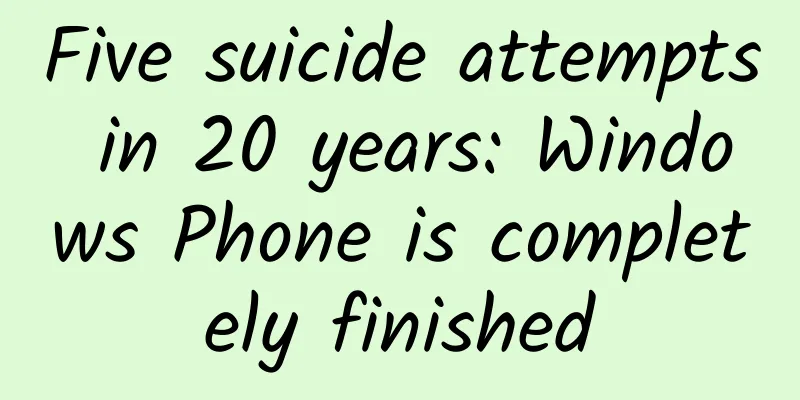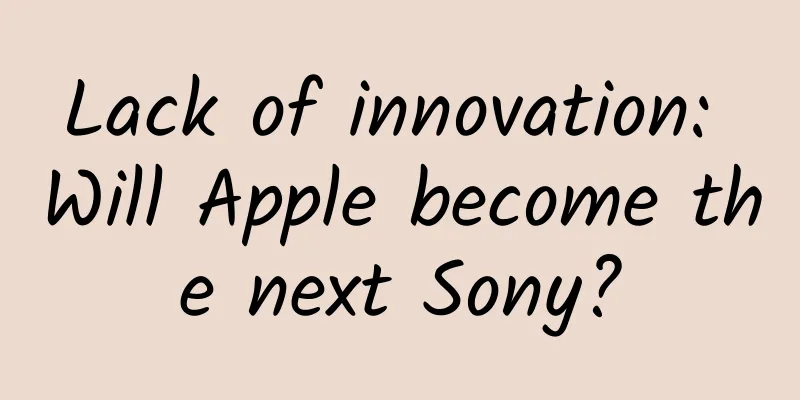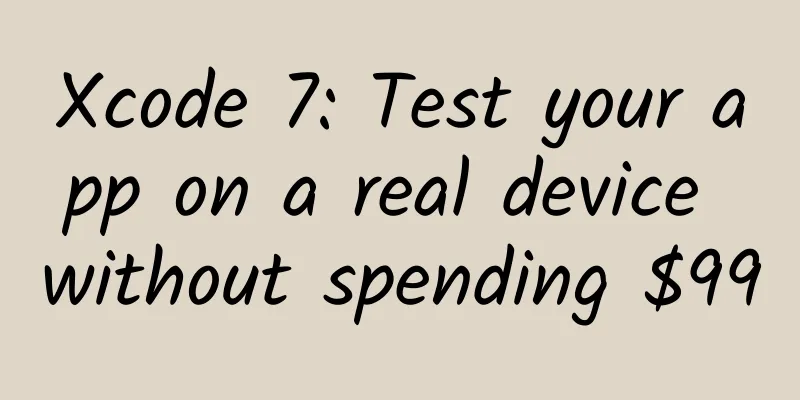Five suicide attempts in 20 years: Windows Phone is completely finished

|
Windows Phone has completely failed. On May 23, Microsoft announced that it would further lay off 1,850 employees in its smartphone business and sell its non-smartphone business to FIH Mobile. So far, Microsoft has laid off more than 26,000 mobile phone-related personnel - the original Windows mobile phone team and employees who joined the acquisition of Nokia have basically left. Terry Myerson, executive vice president of Microsoft's Windows and Devices Division, said in an email to department employees: The success of our mobile phones is limited to corporate customers and individual consumers who are concerned about security, ease of management and collaboration, so our mobile phone hardware business will be more focused. - Terry Myerson Although he said that Microsoft will continue to develop Windows 10 Mobile, the meaning of the email is very clear: Microsoft is no longer paying attention to the consumer smartphone market. Microsoft is one of the earliest companies in the world to get involved in smartphones. The predecessor of the mobile operating system, Windows CE, was born as early as 1996. In 2000, the touch-screen operating system PocketPC2000 designed for mobile devices was launched. In 2002, the first smartphone based on the Microsoft system, Orange SPV, was released. Also in 2002, Apple had just recovered from the recession, and the iPod was still a niche product that few people bought; Google had only been established for four years and had not yet gone public. The iPhone and Android phones were not released until 2007 and 2008 respectively. Today, almost all smartphones in the world are iOS and Android. How did Microsoft mess it all up? At the turn of the century, Nokia ruined its plan to copy the PC. Windows CE was born in 1996. The initial version was based on the streamlined development of Windows 95, and the user interface inherited Microsoft's classic element, the start menu. The business model envisioned by Microsoft was the same as that of the PC - Microsoft made the operating system, mobile phone manufacturers produced hardware, and paid licensing fees for each mobile phone equipped with the Windows system. At that time, Bill Gates frequently showed goodwill to Nokia, hoping that this fast-growing mobile phone giant would join him. The two sides were also promoting a plan called Phoenix. But Nokia did not want to be a coolie for Microsoft like PC manufacturers. In June 1998, Nokia, together with Ericsson, Panasonic, and Motorola, the top manufacturers in the mobile phone market at the time, invested in the software department split from the British PDA company Psion and established Symbian. Feeling betrayed, Gates angrily wrote the famous email: "We are disappointed that Nokia never told us that they were going to unite." "Whatever Symbian does, it will be harmful to us." In March 1999, the Symbian 5.0 operating system was released. It can make calls, surf the Internet, send emails, and support Java third-party applications, which is much easier to use than Windows CE. After that, Sony, Sanyo, Fujitsu and other companies also joined the Symbian Alliance. Microsoft, which does not manufacture hardware itself and relies on third-party manufacturers, has no one to cooperate with, so it had to find HTC, a Taiwanese company that no one knew at the time and started out as a foundry business. But a smartphone must first be a good phone with attractive hardware. HTC is obviously not particularly good at this: The first Windows phone, HTC Orange SPV By 2003, Symbian accounted for 66.6% of the global smartphone market, while Microsoft only had 22%. In the pre-iPhone era, Microsoft gave up the right path Since PocketPC 2000, Microsoft's mobile operating system has supported touch screens. But Microsoft's touch screens are designed for pens, and you even have to click the start menu in the upper left corner of the screen. From today's perspective, we can criticize Microsoft for "sticking to the PC idea", but we cannot deny that compared with keyboard phones, touch screens are the future, but they need major improvements. Left: PocketPC2000 user interface Right: Windows Mobile 6.1 user interface But when touch-screen phones failed to sell, Microsoft turned to keyboard design. In 2005, Microsoft and Palm, its former rival, announced a partnership and launched the Treo 700W with Windows Mobile 5. The Treo 700W has a full keyboard and a touch screen, but the operating interface has not changed much. Windows Mobile seems to have been forced in. Left: Motorola Q9 Right: Palm Treo 700w In 2006, Microsoft and Motorola worked together again to launch the Q series of full-keyboard Windows Mobile phones. This time it was even more extreme, as the Motorola Q9 simply did not support touch screens. At this time, Apple's iPhone was already under development. At the 2007 Macworld Conference, Jobs showed off Motorola Q, Palm Treo, Blackberry, and Nokia E92 to highlight how promising the iPhone's interactive method was. At the iPhone launch event, Jobs mocked competitor Microsoft for not spending several years like Apple to solve the challenge of touch screens, but chose to turn around and do the same thing as traditional competitors who rely on keyboards. Ironically, Microsoft's most important partner HTC has already known that touch screens are the future. In the same year as the iPhone was released, HTC released the HTC Touch in June 2007. Although this phone uses Windows Mobile, it has a brand new user interface for the first time, which is more convenient for finger operation. The first generation of iPhone vs. HTC Touch, both products were launched in the middle of 2007. Since Microsoft itself did not optimize for finger control, HTC customized an interface called Touch FLO. This attempt to improve the shortcomings of the operating system was later adopted by HTC on the Android system and launched Sense. People familiar with HTC must know that HTC has a famous mobile phone: HTC HD2. The HTC Sense interface used in this phone is very exquisite, with a multi-touch capacitive screen and no need for a stylus. It is almost impossible to tell that the HD2 is a phone using the Windows system. Left: HTC Touch Right: HTC HD2 Unfortunately, it was born in 2009, and the iPhone solved the finger problem in 2007, and solved it better. Facing Android, Microsoft was several steps behind . The release of the iPhone stimulated all mobile phone manufacturers, including Microsoft. Google reacted quickly. There is a story that describes the reaction of Andy Rubin, the head of Android at the time. On the morning of the iPhone release, Rubin was on his way 600 miles from Las Vegas to meet with operators at the CES exhibition. He was extremely surprised to see the iPhone in Jobs' hand on TV, and immediately asked the driver to stop the car. Fortunately, he watched the press conference online. He commented on the future of Android that was brewing: "I guess our phone will not be released." Later we learned that Android at the time used a full keyboard design, and the prototype looked very much like BlackBerry. A year later, Android 1.0, with a completely new user interface, was unveiled. The planned first generation of Android phones Sooner In fact, the first generation of Android phones on the market, HTC Dream, clearly showed that the importance of touch screens was increased. Compared with Google Android, which quickly transformed from scratch, Microsoft was very confused after the release of iPhone. In January 2007, iPhone was released. In February, Microsoft released Windows Mobile 6.0. In April 2008, Windows Mobile 6.1 was released with minor revisions. Until mid-2009, Microsoft was still busy pushing forward the update of Windows Mobile 6.5 - compared with iPhone, it was still minor revisions. Also in 2007, Google joined HTC, Broadcom, LG, Samsung and other companies to establish the Open Handheld Device Alliance. In 2008, the first consumer version of Android phone, HTC G1, was born. In 2009, Android quickly iterated to version 1.5, supporting virtual keyboards, gravity sensors and multiple languages including Chinese. At this time, iPhone 3GS had been released and App Store had been online for almost a year. Faced with the powerful iPhone, more and more operators and mobile phone manufacturers chose the friendly and open source Android. Ironically, Andy Rubin, who resisted pressure within Google and promoted the Android system, worked briefly at Microsoft. His early mobile phone startup Danger was acquired by Microsoft, but he left Microsoft shortly after the acquisition to start Android and joined Google with Android. In 2010, Windows Phone 7, which was redeveloped for finger control, was released. But in the same year, Verizon, the largest operator in the United States, jointly launched the Android phone Droid with Motorola. This was the first Android phone to sell more than one million units. Soon after, Samsung released the Galaxy S, opening up today's most successful high-end Android series of phones. Microsoft was too slow. Windows Phone 7 was released, but Microsoft chose the wrong competitive target. Windows Phone 7, released in October 2010, is an important product with a unique interface design, unlike Android, which simply imitates the iPhone. The advanced design language was later imitated by other products. Nokia Lumia 800 Objectively speaking, the shortcomings of Windows Phone 7 that were widely criticized when it was first released, such as the lack of copy and paste functions, are not very serious. At least, when the first generation of iPhone was released, there was no copy and paste and multitasking. However, the iPhone could have these shortcomings in 2007, but Windows Phone 7, which was released three years later, could not because it was a latecomer. Microsoft's choice of iPhone to compete is not only problematic in front of consumers, but also unable to convince manufacturers. Third-party manufacturers do not need to pay licensing fees to use Android, while Microsoft charges dozens of dollars in licensing fees for each Windows Phone. At the same time, manufacturers cannot adjust the interface of Windows Phone - Microsoft regards unified design as the focus of competition with iPhone. As a result, Windows Phone 7 phones of any brand are the same, with almost no difference. Mobile phone manufacturers will not regard platforms that cannot highlight their own differentiation as the main force. In October 2010, Android's market share had reached 30%. Choosing to compete with iPhone, Microsoft lost the opportunity to snatch Android customers. Windows Phone 8, internal fighting at a critical moment In 2011, Microsoft finally pulled in a heavyweight partner who went all out - Nokia, which destroyed Microsoft's mobile phone market that year. Before cooperating with Microsoft, Nokia had negotiated with Google to join the Android camp, but Google was unwilling to give Nokia a discount. Unfortunately, Nokia may not have realized at the time that cooperating with Microsoft would not only not help it, but would also slow it down. When the cooperation just started in 2011, Microsoft's Windows Phone system updates suddenly stopped. It was not until the summer of 2012 that Windows Phone 8 was released. Microsoft proudly announced that Windows Phone 8 was a brand new beginning, abandoning the Windows CE core and using the same Windows NT as Windows 8. In the future, applications on Windows will be directly universal, and mobile phones and PCs will be able to work seamlessly. At this critical juncture when the product is just starting, why would Microsoft start over again and focus on the core? Within Microsoft, departments are divided according to product lines, and each department has its own market and sales, and has separate revenue figures. Under such a structure, the department that makes more money naturally has a greater voice. Microsoft's mobile business originally belonged to the Windows Phone team. But when mobile became a trend, the Windows department wanted to get involved. At this time, Microsoft's priority in making mobile phones changed from quickly improving products to catch up with Android and iPhone to cooperating with the PC business - using a unified Windows 8 operating system to cover mobile phones and PCs. In the two years that Nokia waited for Windows Phone 8, iPhone sales tripled and Android sales more than sixfold. When the iPhone was first launched, Nokia, BlackBerry, and Microsoft all publicly mocked this competitor. But behind the scenes, Nokia and BlackBerry's management had already taken action. Nokia increased the priority of the touch-screen Linux operating system Maemo, and BlackBerry also launched the touch-screen phone Storm in 2008 to fight back. In the end, these two mobile phone manufacturers who were not good at platform and software failed to catch up with Apple and Google. Microsoft, which has stronger software engineering capabilities and platform experience (Windows was once the largest platform), has been advancing Windows phones at a leisurely pace, and even stopped the development of mobile systems to wait for Windows 8. Nokia's most ironic product may be the camera phone Pureview 808 launched in 2012 - with a huge 41-megapixel sensor. One year after announcing the abandonment of Symbian and switching to Windows, Nokia made such a product using the Symbian system. The reason? Microsoft Windows Phone 8 did not come and did not support the processor required for the camera module. Nokia Pureview 808 series of failures, Microsoft lost opportunities worth $600 billion It can be said that after 2012, the mobile market has no real relationship with Microsoft, even though it spent more than $9 billion to acquire Nokia. Today, this money has been completely wasted, and more than 20,000 employees who came to Microsoft with Nokia have been laid off. Microsoft also gave up the Nokia brand and sold its feature phone business to FIH Mobile. In addition to the $7.2 billion wasted, Microsoft also lost the opportunity to dominate the smartphone market. Since the release of the iPhone in 2007, Apple has earned a total of $597.7 billion in revenue from selling iPhones, not including the revenue from other businesses such as AppStore, tablets, and watches driven by the iPhone. Today, the sales of iPhone and Android each quarter far exceed the total sales of Windows phones + PCs. The market value of Apple and Google is also far greater than that of Microsoft: Microsoft is still very profitable with enterprise services such as Office, server software and cloud computing. But like IBM in the past, it has gradually become isolated from consumers, and all this is because of the failure of the mobile market. As a winner of Toutiao's Qingyun Plan and Baijiahao's Bai+ Plan, the 2019 Baidu Digital Author of the Year, the Baijiahao's Most Popular Author in the Technology Field, the 2019 Sogou Technology and Culture Author, and the 2021 Baijiahao Quarterly Influential Creator, he has won many awards, including the 2013 Sohu Best Industry Media Person, the 2015 China New Media Entrepreneurship Competition Beijing Third Place, the 2015 Guangmang Experience Award, the 2015 China New Media Entrepreneurship Competition Finals Third Place, and the 2018 Baidu Dynamic Annual Powerful Celebrity. |
<<: Counterpoint: Global semiconductor industry revenue to grow 17% in the third quarter of 2024
Recommend
How do content-based products go global from Douyin, Toutiao, UC Headlines, etc.?
2018 marks a new stage for China’s Internet going...
Amazon Amazon Global Store FBA Logistics Practical Course Value 518 Yuan (Completed)
Amazon Amazon Global Store FBA Logistics Practica...
Nanjing Mobile 4G users were cheated and cried: the phone lost connection after turning on
After the TD-LTE license was officially issued at ...
Understand everything about iOS development language in one article!
Preface What are the iOS development languages? W...
28 essential tools for new media operations in 2021!
What tools are needed for a complete campaign? On...
5 Brand Promotion Strategy Models
The market is changing, the industry is changing,...
Have you ever been affected by these noises at home? 3 ways to reduce the noise!
It’s so noisy! This is probably our most direct a...
APP advertising growth: dynamic product advertising
Dynamic product ads can be precisely delivered ba...
Wuhan tea sn post bar
Wuhan Tea Tasting Contact Information I strongly ...
How to build a complete growth model?
Today we will talk about three aspects: what is a...
The core of natural language processing: sequence learning
Everything in life is time-related, which forms a...
New research: Once this core organ ages, the functions of the whole body will "regress"
The liver is an important detoxification organ in...
The US National Highway Traffic Safety Administration recommends simplifying in-car interactive operations and changing radio stations within 12 seconds
According to foreign media reports, the National ...
Useful information | A guide to Weibo Fans Channel placement in the education industry!
The online education industry is booming, and mar...
The most effective App promotion channels, a summary of strengths!
What are the most effective App promotion channel...









